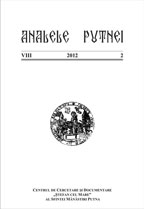Din istoria scrierii de carte la Mănăstirea Putna în secolele al XV-lea – al XVI-lea (copiştii şi cărturarii sfântului lăcaş)
On the History of Book Copying at the Putna Monastery in the 15th–16th Centuries (The Scribes and Scholars of the Holy Place)
Author(s): Alexandru PascalSubject(s): History
Published by: Centrul de cercetare şi documentare ŞTEFAN CEL MARE
Keywords: calligraphers; manuscripts; palaeography; Putna Monastery; repertoire; scriptorium
Summary/Abstract: The paper is dedicated to the reconstruction of the repertoire of the Putna Monastery’s Scriptorium, the most important workshop for manuscript books in the 15th–16th centuries Moldavia. Without pretending to have made an exhaustive research, the author reaches the conclusion that the compilation of a chronological catalogue with the scholars and scribes of the monastery in the 15th–16th centuries, a task undertaken several times by Romanian and foreign researchers, either by cataloguing and inventorying the manuscript archives from various countries (A. I. Iaţimirski, Paulin Popescu, Radu Constantinescu, Ion-Radu Mircea, Damaschin Mioc, P. P. Panaitescu, Anne E. Pennington etc.) or by performing a specialized research (E. Turdeanu, Maria Magdalena Székely) cannot be considered completed, because such a task should be based mainly on the direct, de visu study of the manuscript books that could have been produced by the book centre from Putna. According to the author, one of the first steps in the process of studying the corpus of manuscript books originating from the Putna Monastery in the 15th–16th centuries should be the compilation of a general palaeographic album with the handwriting of the known scholars and calligraphers of the monastery, together with a detailed description of the codicological characteristics of the manuscripts they created. The album would then help the specialists to establish the paternity of the anonymous Slavic-Moldavian manuscripts from that time, manuscripts that are found nowadays in Romania and in many other countries (Russia, Ukraine, Bulgaria, Greece, Poland, Austria etc.). Based on the study of several Putna manuscript books from the Moscow and Saint Petersburg archives the author proves the possibility of such clarifications about Putna’s Scriptorium repertoire and publishes several samples of the palaeographic peculiarities of the manuscripts from the Moscow archives.
Journal: Analele Putnei
- Issue Year: 2012
- Issue No: 2
- Page Range: 65-110
- Page Count: 46
- Language: Romanian
- Content File-PDF

